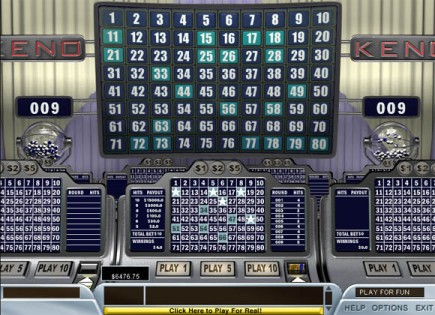The History of Keno
 Keno lottery was originally referred to as the Chinese lottery. This game was actually said to have originated from an ancient poem entitled “The Thousand Character Classic,” This poem has about a thousand rhymes that are never repeated. The game was used as an aid in teaching the children to learn about the thousand characters that they needed to be able to learn and read during their time.
Keno lottery was originally referred to as the Chinese lottery. This game was actually said to have originated from an ancient poem entitled “The Thousand Character Classic,” This poem has about a thousand rhymes that are never repeated. The game was used as an aid in teaching the children to learn about the thousand characters that they needed to be able to learn and read during their time.
Keno began as a very popular nursery rhyme in ancient China. A legendary Chinese general named Cheung Leung was the one who generated the game of Keno. This general used the initial 120 characters of “The Thousand Character Classic” in order to create a gambling game. The correct numbers are marked by their ancient way of writing through ink and brush, and the winner gets prizes if the numbers are guessed correctly. Cheung Leung used the profit from this new game that he devised to serve as funding for the equipment and arms that he needed for military defense. He used the money to buy armaments, weapons, etc. to help him protect his kingdom from any invaders.
The 120 symbols that were used in the ancient keno lottery game were further divided into 8 sub-categories. At least two times a day, the emperor would randomly draw the combinations. The mechanics of the game is like this: if the players lose in one subcategory, then they will lose in their 3 more bets. On the other hand, if they win in one sub category, they would end up winning 10 more bets.
During the course of time, keno was also called as the “White Pigeon Game.” It was called this way because in those ancient times when there were no other faster means of communication, pigeons were used to deliver the results of the ancient keno game throughout the Emperor’s immense kingdom.
When the game gained popularity, so did Cheung Leung’s army. Because of the money, he was able to gain as profits from this game that he had invented, (just 10 lottery draws) and his army was reinstated back to the government.
There was also another term that was used frequently by Chinese scholars for the ancient lottery game. Since the money that was gained from the keno games were used to fund Cheung Leung’s army, this game was labeled as “idiot taxes.” The Chinese scholars felt that those who participated in this game were just robbed of their money — instead of directly asking for taxes to supply the government’s army, the so-called “idiots” were fooled into gambling instead. It was also said that much of the profit from these games were also used for the funding of the building of the Great Wall of China.
Even now, in present day China, the Chinese still call Keno the “Thousand Character Classic” and it has become a part of their tradition to play this twice a day like it has always been played in the past. Instead of the 1,000 characters, only 80 are picked to be put into the cards. Each subcategory is divided by 10 characters.
Keno reached North America in the 19th century due to the immigration of some Chinese who brought along this game with them. This was during the time of the Gold Rush, which is why there were a number of Chinese miners who went to North America. As time passed, this game of Chinese lottery reached California, Nevada, and other parts of North America to become the popular gambling game that it is now.